Global Market Comments
June 14, 2018
Fiat Lux
SPECIAL GOLD ISSUE
Featured Trade:
(GUESS WHO'S BEEN BUYING GOLD?),
(GLD), (GDX), (SLV), ($SSEC),
(WILL GOLD COINS SUFFER THE FATE OF THE $10,000 BILL?),
(GLD), (GDX),
(TESTIMONIAL)

Global Market Comments
June 14, 2018
Fiat Lux
SPECIAL GOLD ISSUE
Featured Trade:
(GUESS WHO'S BEEN BUYING GOLD?),
(GLD), (GDX), (SLV), ($SSEC),
(WILL GOLD COINS SUFFER THE FATE OF THE $10,000 BILL?),
(GLD), (GDX),
(TESTIMONIAL)

Gold bugs, conspiracy theorists, and permabears had some unfamiliar company last year.
While traders, individuals, and ETFs have been unloading gold for the past five years, central banks have been steady buyers.
Who had the biggest appetite for the barbarous relic?
Russia, which has been accumulating the yellow metal to avoid economic sanctions imposed by the United States in the wake of its invasion of the Ukraine.
Hot on its heels was China, which has flipped to a large net importer of gold to meet insatiable demand from domestic investors. China appears to be buying about 20 metric tonnes a month of the barbarous relic.
It seems the Chinese stocks markets ($SSEC) were not the great trading opportunity that they were hyped to be, which plunged 30% during the first two months of 2016, and is now 60% off its all-time high.
That's a big deal in a country that has no social safety net.
Many Chinese now prefer to buy gold instead of stocks, which are now considered too risky for a personal nest egg.
They are facilitated by the ubiquitous precious metal coin stores, which have recently sprung up like mushrooms in every city.
Only a few years ago, private ownership of gold resulted in China having your organs harvested by the government.
Central bank sellers have been few and far between. Venezuela has dumped about half its reserve to head off a recurring liquidity crisis.
Middle Eastern sovereign wealth funds cashed in some chips to deal with the oil price crash.
Canada has also been selling for reasons unknown to us south of the border.
All of this poses a really interesting question. Gold fell for the four consecutive years that central banks were buying, and the rest of the world was selling.
What happens when the rest of the world flips to the buy side?
My guess is that it goes up, which is why I have issued long side Trade Alerts on gold this year.




Global Market Comments
May 4, 2018
Fiat Lux
Featured Trade:
(DON'T MISS THE MAY 9 GLOBAL STRATEGY WEBINAR),
(A DAY IN THE LIFE OF THE MAD HEDGE FUND TRADER),
(SPY), (TLT), (TBT), (FXE),(GLD), (GDX), (USO),
(AMLP), (STBX), (NFLX), (DIS), (AAPL), (GM)

Global Market Comments
May 3, 2018
Fiat Lux
Featured Trade:
(STORAGE WARS),
(MSFT), (IBM), (CSCO), (SWCH),
(DON'T BE SHORT CHINA HERE),
($SSEC), (FXI), (CYB), (CHL), (BIDU),

Everyone who has been reading this letter for the past decade (yes, there are quite a few of you), know that I am a fundamentalist first and a technician second.
Of course, you need to use both, as those who mistakenly leave one tool in the bag reliably underperform indexes.
The one-liner here is that I use fundamentals to identify broad, long-term, even epochal trends, and technicals for the short-term timing of my Trade Alerts.
Do both well, and you will prosper mightily.
Strategists often like to cloak themselves in the fundamental or technical mantels alone. But parse their words carefully, and the best fundamentalists talk about support and resistance levels, while the ace technicians refer to the latest economic data points.
The reality is that the best of the best are using both all the time. The differential titles have more to do with marketing purposes than anything else.
Having said all that, you better take a good, hard look at the chart below for the Shanghai Stock Exchange Composite Index ($SSEC). The 2016 low has held and the long-term uptrend lives.
My bet is that it resolves to the upside. All it would be doing then is coming in line with the rest of the global equity markets, including those of many emerging markets.
Since the last top, the earnings multiple of Chinese companies has plunged, from 35 times to a mere 15 times. This means that the 6.5% a year growing economy (China) is trading at a lower multiple than the 2.3% a year growing one (the U.S.). The big question among strategists since 2009 has been how far these valuations would diverge.
If I am right, then you can expect a rally of at least 25% in the Shanghai market soon, and more in peripheral markets, such as Hong Kong (EWH) and in single Chinese names. My bet is that it starts in August, when the current correction ends and we resume the year-end ramp-up.
You should place a laser-like focus on the Chinese Internet sector, so you won't go wrong picking up some Baidu (BIDU) around $180, if you can get it (click here for my original recommendation to buy the stock at $12 nine years ago).
If you are looking for further confirmation of the coming bull move in China across asset classes, please peruse the chart below for copper. The red metal has one of the closest correlations out there with the fate of the Middle Kingdom's economy and stock markets. It appears to be breaking out of a major five-year downtrend as well.
The other nice thing about this scenario is that it provides more fodder for my expectation of another global bull market move in the fall, when you can expect major indexes to tack on another 10% by year-end.
Jim Chanos, watch your back!
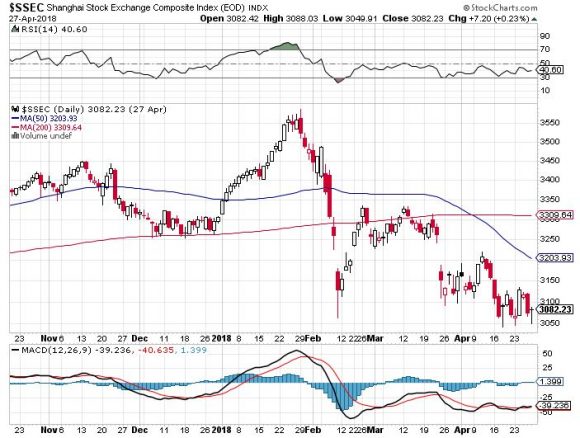
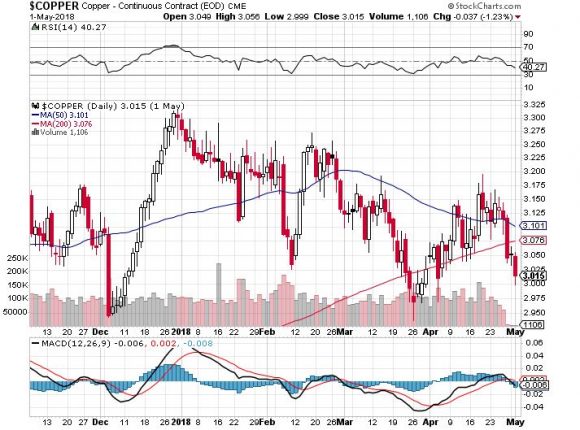
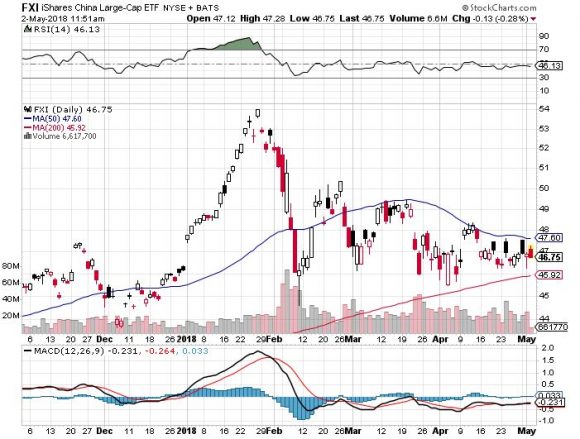
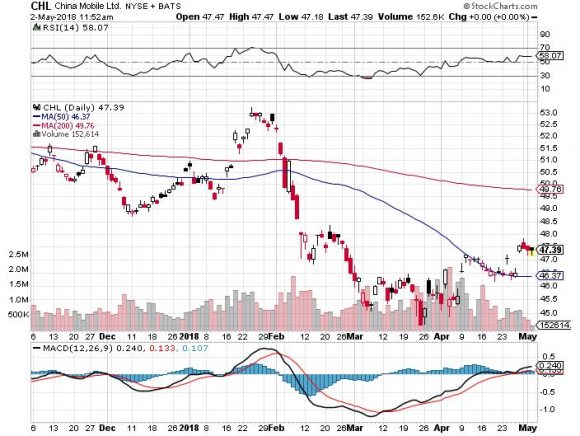
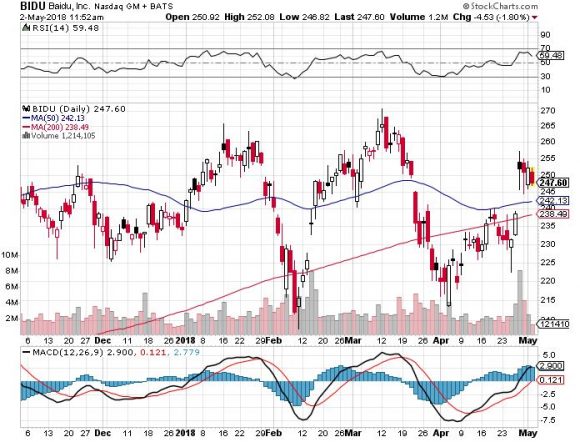

When I first visited Calcutta in 1976, more than 800,000 people were sleeping on the sidewalks.
I was hauled everywhere by a very lean, barefoot rickshaw driver, and drinking the water out of a tap was tantamount to committing suicide.
Aggressive population control measures where underway, and strict quotas were in force. Everyone was taking their grandmother in to get sterilized.
Some 38 years later, and the subcontinent is poised to overtake China's white hot growth rate.
My friends at the International Monetary Fund just put out a report predicting that India will grow by 8.5% this year. While the country's total GDP is only a quarter of China's $6 trillion, its growth could exceed that in the Middle Kingdom as early as 2018.
Many hedge funds believe that India will be the top growing major emerging market for the next 25 years, and are positioning themselves accordingly.
India certainly has a lot of catching up to do. According to the World Bank, its per capita income is $3,275, compared to $6,800 in China and $46,400 in the US. This is with the two populations close in size, at 1.3 billion for China and 1.2 billion for India.
But India has a number of advantages that China lacks. To paraphrase hockey great, Wayne Gretzky, you want to aim not where the puck is, but where it's going to be.
The massive infrastructure projects that have powered much of Chinese growth for the past three decades, such as the Three Gorges Dam, are missing in India. But financing and construction for huge transportation, power generation, water, and pollution control projects are underway.
A large network of private schools is boosting education levels, enabling the country to capitalize on its English language advantage.
When planning the expansion of my own business, I was presented with the choice of hiring a website designer here for $60,000 a year, or in India for $5,000.
That's why booking a ticket on United Airlines or calling technical support at Dell Computer gets you someone in Bangalore.
India is also a huge winner on the demographic front, with one of the lowest ratios of social service demanding retirees in the world.
Even though it has recently been terminated, China's 30-year-old ???one child??? policy is going to drive it into a wall in ten years, when the number of retirees starts to outnumber their children.
There is one more issue out there that few are talking about. The reform of the Chinese electoral process at the People's Congress in 2013 could lead to posturing and political instability, which the markets could find unsettling.
India is the world's largest democracy, and much of its current prosperity can be traced to wide ranging deregulation and modernization than took place 20 years ago.
I have been a big fan of India for a long time, and not just because they constantly help me fix my computers, make my travel reservations, and tell me how to work my new altimeter watch.
In August, I recommended Tata Motors (TTM), and it has gone up in a straight line since, instantly making it one of my top picks of the year. On the next decent dip take a look at the Indian ETF's (INP), (PIN), and (EPI).
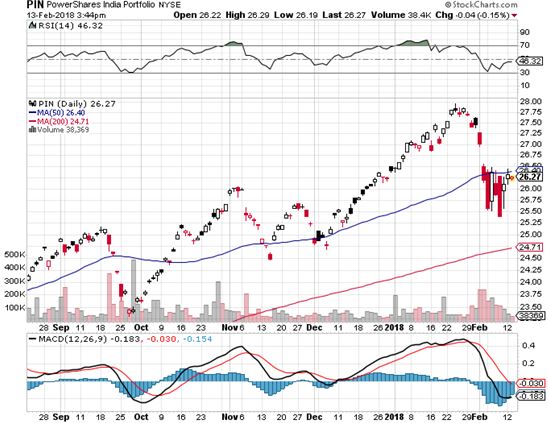
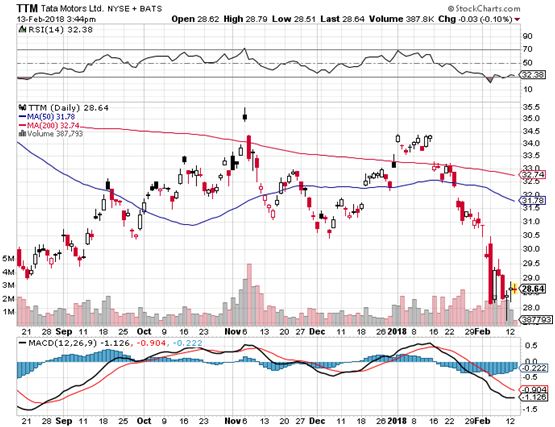

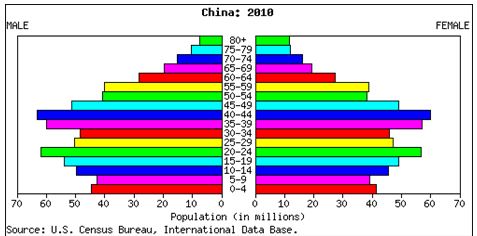

Everyone who has been reading this letter for the past eight years (yes, there are quite a few of you), know that I am a fundamentalist first and a technician second.
Of course you need to use both, as those who mistakenly leave one tool in the bag reliably underperform indexes.
The one liner here is that I use fundamentals to identify broad, long term, even epochal trends, and technicals for the short-term timing of my Trade Alerts.
Do both well, and you will prosper mightily.
Strategists often like to cloak themselves in the fundamental or technical mantle. But parse their words carefully, and the best fundamentalists talk about support and resistance levels, while the ace technicians refer to the latest economic data points.
The reality is that the best of the best are using both all the time. The differential titles have more to do with marketing purposes than anything else.
Having said all that, you better take a good, hard look at the chart below for the Shanghai Stock Exchange Composite Index ($SSEC). This is a classic narrowing triangle spread over the entire five years of the Chinese bear market that is imminently going to explode one way or the other.
My bet is that it resolves to the upside. All it would be doing then is coming in line with the rest of the global equity markets, including those of many emerging markets.
Since the top, the earnings multiple of Chinese companies have plunged, from 35 times to a mere 15 times. This means that the 6% a year growing economy (China) is trading at a lower multiple than the 2% a year growing one (the US). The big question among strategists since 2009 has been how far these valuations would diverge.
If I am right, then you can expect a rally of at least 25% in the Shanghai market soon, and more in peripheral markets, like Hong Kong (EWH) and in single Chinese names.
The rally will also place a laser like focus on the Chinese Internet sector, so you won?t go wrong picking up some Baidu (BIDU) around $180, if you can get it.? I originally recommended buying the stock at $12 seven years ago.
If you are looking for further confirmation of the coming bull move in China across asset classes, please peruse the chart below for copper. The red metal has one of the closest correlations out there with the fate of the Middle Kingdom?s economy and stock markets. It appears to be breaking out of a major three-year downtrend as well.
The other nice thing about this scenario is that it provides more fodder for my expectation of another global bull market move in the fall, when you can expect major indexes to tack on another 5% by yearend.
Jim Chanos, watch your back!
Don?t waste your time trying to analyze financial markets right now.
There is only one ticker symbol you need to know about, that for the Shanghai Stock Exchange Composite Index, the ($SSEC).
When Shanghai goes up, the rest of the world?s risk assets happily join the party. When it drops, ?RISK OFF? fever goes pandemic.
China upped the ante this week when it allowed its currency, the Yuan, or the renminbi as it is known locally (the people?s currency), to float freely for the first time in 25 years. That produced a two-day devaluation of 3.6%.
In the very long history of currency debasements, this one was barely a whimper.
Ancient Sumerians used to shave the edges off of gold and silver coins 5,000 years ago.
When President Nixon took the US off of the gold standard in 1973, the dollar eventually fell 75% against the European currencies.
More recently, the Euro has given up 37% against the greenback, moving from a position of grotesque over valuation to dealing with the Greek credit crisis.
So Beijing?s move this week barely tips the needle in the official history of devaluations.
What it does do is create a giant psychological effect, and therein lies the problem.
Since June, the Mandarins in China have been pulling out all the stops to halt a free fall in the country?s share prices.
It has cut interest rates and relaxed reserve requirements. It banned high frequency trading, blaming the collapse on foreign short sellers (sound familiar?). It has even made stock selling illegal in roughly 94% of the country?s free float.
Still, the bears remain emboldened by their recent success.
By cutting the value of the Yuan, the government is providing a modest boost to the economy. A cheaper currency means less expensive exports and more of them, thus, making local businesses more profitable and creating jobs.
But not by much.
There are not a lot of products that live or die on a 3.6% margin. America has not just lost a chunk of its own exports from the additional competition, contrary to the claims of the TV networks and bogus newsletters with which I compete.
But by taking the first such move to undercut the Yuan in 25 years, it is showing the world how serious a problem is the stock crash.
Will the stock collapse feed into the main economy? Is 10% of the world?s GDP going into a Great Recession? Yikes!
SELL, SELL!
There are a few other problems with the Chinese firecracker.
It violates a secret agreement with the US government, made a decade ago, to allow a steady 3-4% a year appreciation of the Yuan against the dollar.
This was designed to slowly eliminate the artificial under valuation of the Yuan that gave the Middle Kingdom an unfair export advantage. The arrangement was responsible for the 20% rise of the Yuan since 2009.
(Sorry Donald, but you?re holding the chart upside down. Yes, I know, stock charts can be pesky things).
Reneging on the deal is ruffling feathers at the US Treasury in Washington. But it won?t amount to more than that, as long as it is temporary.
Which it will be.
China still has a massive trade surplus with the United States. In 2014, it totaled a staggering $343 billion. It maintained that heady pace, totaling $171 billion during the first half of 2015.
There are an awful lot of Chinese clothes, electronics, and toys sitting on the shelves of American retailers.
Its imports are falling, thanks to the collapse of the price of oil and other bulk commodities.
The natural state of the currency of any country running such huge surpluses is for it to rise in value. That will continue in China?s case for the foreseeable future.
Once the waters settle in the stock market, you can count on the Yuan to regain its upward path.
However, this isn?t going to happen in a day. It could be weeks or months until order returns to Chinese equity markets. Until then, expect some scary days there and here as well.
Compound these problems with the uncertainty over the Federal Reserve?s decision on interest rates in September and slower than expected US growth.
It certainly leaves traders and investors alike, with a full plate of issues to consider.
As if we didn?t have enough to worry about.
For some background on my 45 year coverage of the Middle Kingdom, please click here for my 2011 SPECIAL CHINA ISSUE.
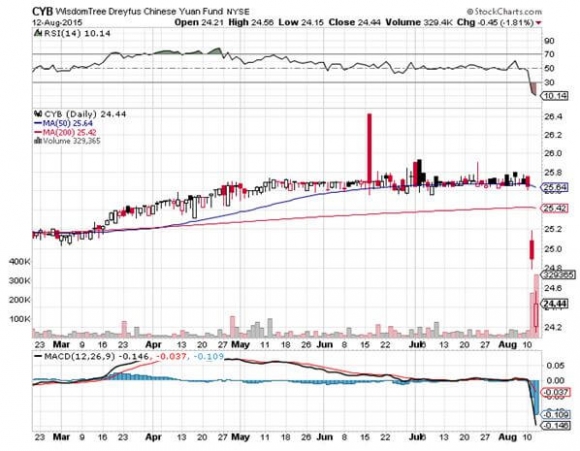
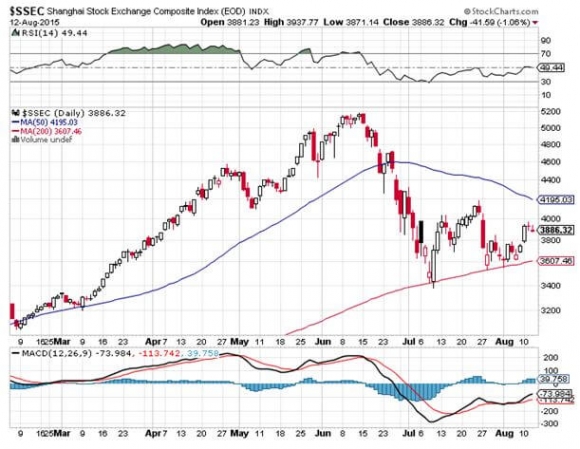
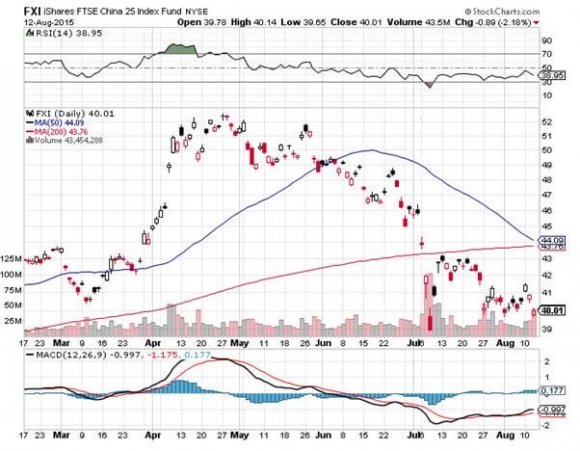
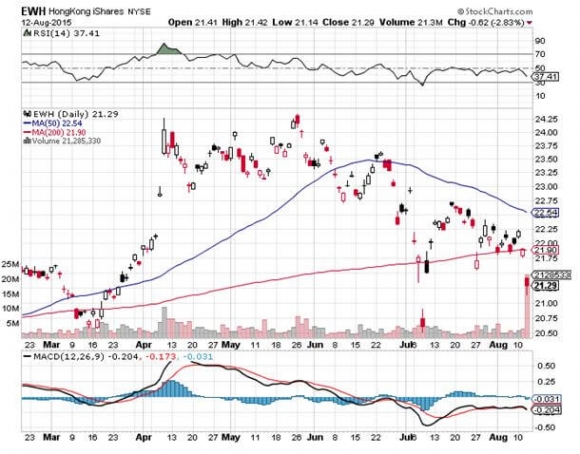
 Surprise!
Surprise!One of the oldest games in the foreign exchange market is to always buy the currencies of strong countries that are growing and to sell short the currencies of the weak countries that are shrinking.
Any doubts that China?s Yuan is a huge screaming buy should have been dispelled when news came out that exports have once again started to surge, thanks to the recovery of its largest customer, Europe.
China?s surging exports of electrical machinery, power generation equipment, clothes and steel were a major contributor.
Interest rate rises for the Yuan and a constant snugging of bank reserve requirements by the People?s Bank of China, have stiffened the backbone of the Middle Kingdom?s currency even further.
That is the price of allowing the Federal Reserve to set China?s monetary policy via a semi fixed Yuan exchange rate.
The last really big currency realignment was a series of devaluations that took the Yuan down from a high of 1.50 to the dollar in 1980. By the mid-nineties, it had depreciated by 84%. The goal was to make exports more competitive. The Chinese succeeded beyond their wildest dreams.
There is absolutely no way that the fixed rate regime can continue and there are only two possible outcomes. An artificially low Yuan has to eventually cause the country?s inflation rate to explode. Or a future global economic recovery causes Chinese exports to balloon to politically intolerable levels. Either case forces a revaluation.
Of course timing is everything. It?s tough to know how many sticks it takes to break a camel?s back. Talk to senior officials at the People?s Bank of China and they?ll tell you they still need a weak currency to develop their impoverished economy. Per capita income is still at only $6,000, less than a tenth of that of the US. But that is up a lot from a mere $100 in 1978.
Talk to senior US Treasury officials and they?ll tell you they are amazed that the Chinese peg has lasted this long. How many exports will it take to break it? $1.5 trillion, $2 trillion, $2.5 trillion? It?s anyone?s guess.
One thing is certain. A free floating Yuan would be at least 50% higher than it is today, and possibly 100%. In fact, the desire to prevent foreign hedge funds from making a killing in the market is not a small element in Beijing?s thinking.
The Chinese government says it won?t entertain a revaluation for the foreseeable future. The Americans say they need it tomorrow. To me that means it?s coming.
Buy the Yuan ETF, the (CYB). Just think of it as an ETF with an attached lottery ticket. If the Chinese continue to stonewall, you will get the token 3%-4% annual revaluation they are thought to tolerate. Double that with margin, and your yield rises to 6%-10%, not bad in this low yielding world. Since the chance of the Chinese devaluing is nil, that beats the hell out of the zero interest rates you now get with T-bills.
If they cave, then you could be in for a home run.
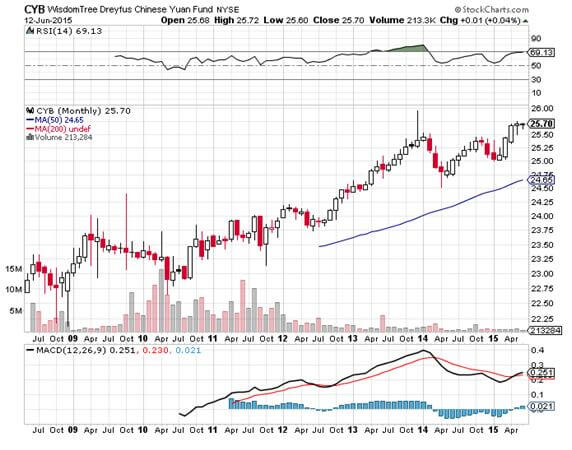
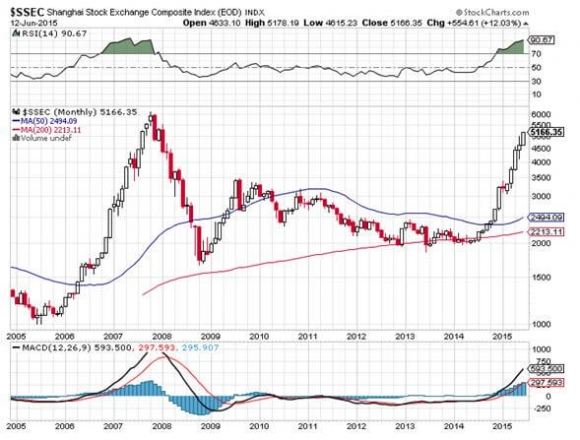
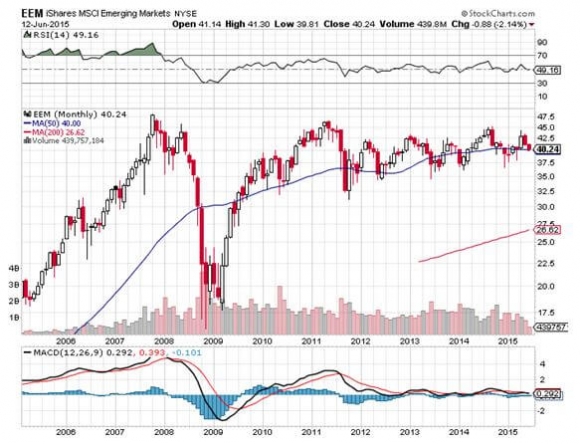
 Ready for a Long Term Relationship with China?
Ready for a Long Term Relationship with China?When Dr. Copper (CU), the only commodity with a PhD in economics, suddenly collapses from a heart attack, risk takers everywhere have to sit up and take notice.
Since the 2011 top, the red metal has collapsed a shocking 38%. It has given back 10% just in the last two weeks. Will copper take down the rest of the financial markets with it?
I don?t think so.
So called because of its uncanny ability to predict the future of the global economy, copper is warning of dire things to come. The price drop suggests that the great Chinese economic miracle is coming to an end, or is at least facing a substantial slowdown, the government?s 7.5% GDP target for 2014 notwithstanding.
This gloomy view is further confirmed by the weakness in the Shanghai index ($SSEC), which has been trading like grim death all year. Will China permabear, Jim Chanos, finally get his dream come true?
It?s a little more complicated than that. Copper is no longer the metal it once was. Because of the lack of a consumer banking system in the Middle Kingdom, individuals are now hoarding 100 pound copper bars and posting them as collateral for loans.
China is, in effect, on a copper standard. Get any weakness of the kind we have seen this year, and lenders panic, dumping their collateral for cash, crushing spot prices.
The latest plunge has been fueled by rumors of an imminent Chinese banking crisis. The Middle Kingdom?s first corporate bond default in history, by a third tier solar company, further heightened fears. The implicit government guarantee that was believed to back this paper has suddenly gone missing in action.
The high frequency traders are now in the copper futures and spot markets in force, whipping around prices and creating unprecedented volatility. Notice how they seem to be running the movie on fast forward everywhere these days? Because of this, we could now be seeing an overshoot on the downside in copper.
The bottom line here is that copper is suffering from its own unique set of difficulties, which will have a negligible affect on other asset classes.
Watch Dr. Copper closely. At the first sign of any real bottom, you should load up on long dated calls for Freeport McMoRan (FCX), the world?s largest producer, which also has been similarly decimated. The gearing in the company is such that a 10% rise in the price of copper triggers a rapid 20% rise or more in (FCX).
I can wax one here about major structural changes in the Chinese economy that are underway, as the real problem. As the Middle Kingdom shifts from an export driven economy to a domestic demand one, there is less need for the red metal and more need for silicon and brains. But this isn?t something you can trade off of today.
So what is copper really to us? The longer-term charts show a prolonged bottoming process. If $2.90 fails, we could see a revisit to the five-year low at $2.50. That?s your load the boat price. During the global synchronized economic recovery that is underway, you want to view every panic sell off in a single asset class like this as a gift.
 Now On Sale
Now On SaleLegal Disclaimer
There is a very high degree of risk involved in trading. Past results are not indicative of future returns. MadHedgeFundTrader.com and all individuals affiliated with this site assume no responsibilities for your trading and investment results. The indicators, strategies, columns, articles and all other features are for educational purposes only and should not be construed as investment advice. Information for futures trading observations are obtained from sources believed to be reliable, but we do not warrant its completeness or accuracy, or warrant any results from the use of the information. Your use of the trading observations is entirely at your own risk and it is your sole responsibility to evaluate the accuracy, completeness and usefulness of the information. You must assess the risk of any trade with your broker and make your own independent decisions regarding any securities mentioned herein. Affiliates of MadHedgeFundTrader.com may have a position or effect transactions in the securities described herein (or options thereon) and/or otherwise employ trading strategies that may be consistent or inconsistent with the provided strategies.
This site uses cookies. By continuing to browse the site, you are agreeing to our use of cookies.
OKLearn moreWe may request cookies to be set on your device. We use cookies to let us know when you visit our websites, how you interact with us, to enrich your user experience, and to customize your relationship with our website.
Click on the different category headings to find out more. You can also change some of your preferences. Note that blocking some types of cookies may impact your experience on our websites and the services we are able to offer.
These cookies are strictly necessary to provide you with services available through our website and to use some of its features.
Because these cookies are strictly necessary to deliver the website, refuseing them will have impact how our site functions. You always can block or delete cookies by changing your browser settings and force blocking all cookies on this website. But this will always prompt you to accept/refuse cookies when revisiting our site.
We fully respect if you want to refuse cookies but to avoid asking you again and again kindly allow us to store a cookie for that. You are free to opt out any time or opt in for other cookies to get a better experience. If you refuse cookies we will remove all set cookies in our domain.
We provide you with a list of stored cookies on your computer in our domain so you can check what we stored. Due to security reasons we are not able to show or modify cookies from other domains. You can check these in your browser security settings.
These cookies collect information that is used either in aggregate form to help us understand how our website is being used or how effective our marketing campaigns are, or to help us customize our website and application for you in order to enhance your experience.
If you do not want that we track your visist to our site you can disable tracking in your browser here:
We also use different external services like Google Webfonts, Google Maps, and external Video providers. Since these providers may collect personal data like your IP address we allow you to block them here. Please be aware that this might heavily reduce the functionality and appearance of our site. Changes will take effect once you reload the page.
Google Webfont Settings:
Google Map Settings:
Vimeo and Youtube video embeds:
